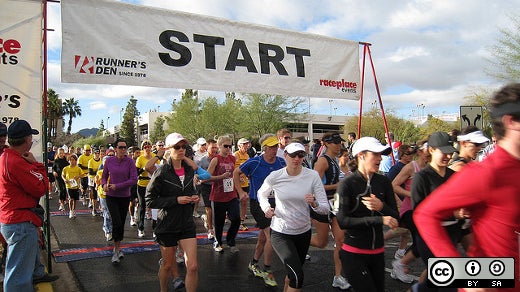It should not surprise you that year after year the most common resolution people make is a combination of lose weight, eat healthier, and get in better shape. This, along with my own resolutions, prompted me to think about what it means to get a company in open source shape.
There are many parallels to a person getting themselves in better physical shape and getting their company in a better position to use open source. Let's take a look at a few of these ways while pulling lessons from exercise and athletic training that can be applied to any enterprise.
The need for a strong set of core muscles (abdomen, lower back, and so on) is well documented in guides to getting in better shape and training for athletic competition. Core muscles form the basis for all daily activities as well as successful athletic pursuits.
The 'core' of your company's open source efforts is rooted in two areas:
- Strategy: the why?
- Governance: the how?
Similar to strengthening your core before taking on a more strenuous physical challenge, it's essential that your company address strategy and governance before you try to run that first 'open source marathon'—like migrating your core business systems to open source technologies. Neglecting this preparation can lead, in both cases, to injuries and time on the sidelines.
Strategy
- What reasons do we have for utilizing open source?
- Will we consume, collaborate, or create in open source (or a combination of these)?
- What is our overall success goal?
Governance
- How do we measure our success?
- How is our open source process built / managed?
- How do we provide a flexible framework for utilizing open source?
Next, consistently evaluate your progress and refine your strategy and governance to reflect changes in your organization and its open source maturity levels. Once you've gotten your open source core in shape, it's time to consider two other important factors: form and motivation.
Form
All athletic endeavors require a proper form, or correct way to perform the exercise or activity. In running, this includes stride length, foot strike position, gait, cadence, etc. Serious athletes spend a lot of time, effort, and money determining the proper technique for their bodies; their form is their foundation—and what they fall back on when they're tired and struggling to get through a tough event.
The same is true for a company's open source form, or process. You don't need to spend a huge amount of time building up a lengthy process, but you should consider what minimum amount of control you need in place to effectively run your open source efforts. This can include such things as legal guidelines on licensing/contribution/adoption, governance models for how you'll run or contribute to communities, and measurement goals for both the organization and individuals.
Once you have this foundation in place, you can fall back on it during critical times when your company may be struggling with how to best implement open source practices. Be careful, though, you don't want to become too rigid with your form / process. Even the best athletes in the world know that sometimes your technique needs to be modified to accommodate an injury or incorporate a new thought process.
Motivation
Dr. Jim Taylor from the University of San Francisco wrote an excellent article in 2009 on the important role of motivation in sports (or exercise and training). In part, he writes:
Motivation in sports is so important because you must be willing to work hard in the face of fatigue, boredom, ...and the desire to do other things.
Anyone who has spent significant time in any corporate job knows that these factors also come into play at work, especially if the endeavor is something new to the company, such as open source utilization. In my experience as an open source consultant, this usually boils down to corporate culture.
Corporate culture can mean many things, but in the case of open source enablement, it usually involves rewards, as well as other intrinsic benefits to the participants. Surprisingly, or maybe not, money is generally not a huge component of the reward system that works in this case. There are certainly individuals who will work harder for something if offered financial rewards, but those that really believe in open source and its benefits, will, like athletes in non-top-tier sports, work feverishly out of internal motivation to do a great job.
In this case, the company can best support them by breaking down barriers to collaboration and community involvement. Also, consider ways of varying the rewards you do give (corporate recognition, ability to influence product/community direction, etc.) Just as athletes vary their workout music (as motivation), so should your organization try to keep its rewards system fresh.
Where to start
All of this may sound a bit daunting, but there are some tangible steps you can take to get started:
- Set goals: short, medium, and long-term
This seems very basic, but a lot of companies forget about this step: think about your utilization of open source and what you can realistically accomplish in incremental, 6-8 month chunks of time. You can always re-evaluate as you go along and adjust your goals as necessary.
- Pace yourself: no one runs a marathon on the first day of training
If you've set realistic goals, this should be easy. However, there will be temptations (as there always are in athletic training) to push yourself too hard or try to take shortcuts. Trust me, you don't want to do that! Just as on the running trail, soccer field, or track, attempting to do too much before your company is ready only leads to setbacks and time on the open source sidelines. Put in the necessary time to get your company eased into an open source transition, and it will pay dividends in the long run.
Finally, at the end of the day, there is no substitute for simply following the advice of the marketing folks at Nike—Just Do It! That single phrase adequately captures the most important part of any resolution to step up your open source fitness. Take that first step!






1 Comment